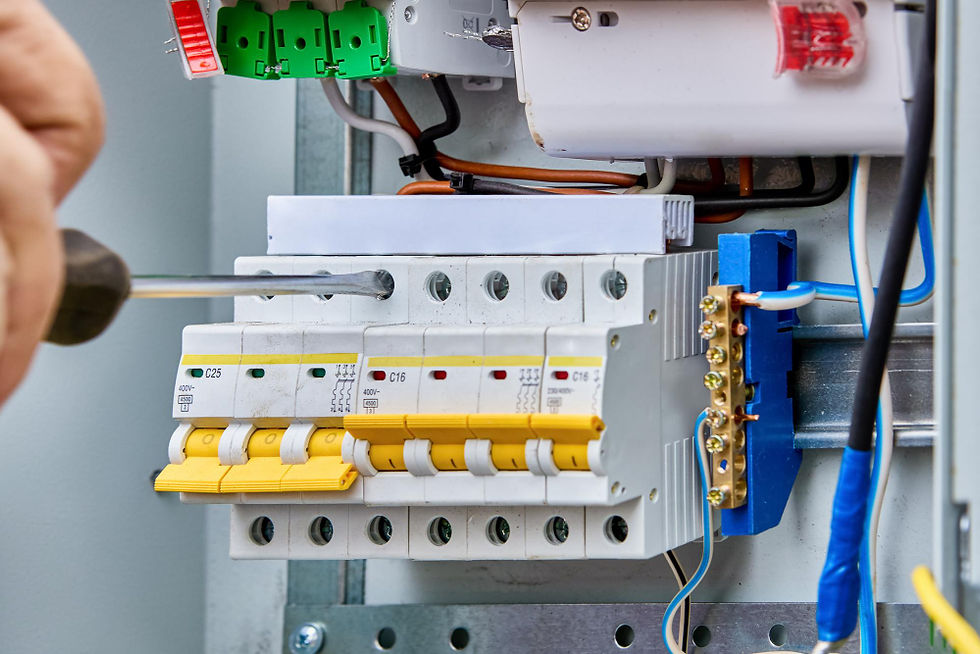What You Need to Know About Circuit Breaker Installation
- thunderbirdelectri9
- Jun 19
- 4 min read

Your home or office runs on electricity. Without it, nothing works. At the center of this system is a small but powerful device—the circuit breaker. If you’re upgrading your electrical system or building a new home, circuit breaker installation is a must.
It’s not just about flipping a switch. It’s about safety, control, and reliability. Whether you’re a homeowner or business owner, understanding the installation process can save you time, money, and stress.
In this blog, we’ll cover everything you need to know about it. From signs you need a new breaker to the process of installation, we’ve got you covered.
Why Circuit Breakers Are Important
It protects your electrical system. They stop the flow of electricity when something goes wrong. For example, if there’s a short circuit or too much power running through the wires, a breaker will trip and cut the electricity. This helps prevent fires and damage to your appliances.
Without a proper installation, your home or office is at risk.
Signs You Need a New Circuit Breaker
Here are some common signs that you may need to install a new breaker:
Frequent tripping: If your breaker trips often, it may be overloaded.
Burning smell: This is a significant warning. It could mean the wires or breaker are overheating.
Old age: Breakers wear out. If yours is over 20 years old, it’s time to replace it.
Physical damage: Cracks or burn marks on the panel are signs of danger.
Buzzing sounds: This may mean there’s a loose connection.
If you notice any of these signs, call a professional. Do not try to fix it yourself unless you are trained. Working with electricity is dangerous.
Types of Circuit Breakers
There are several types of breakers. The one you need depends on your system and usage.
Standard Breakers
These are the most common. They handle simple wiring systems in homes.
GFCI Breakers
These are used in bathrooms, kitchens, and outdoor areas. They protect you from electrical shocks by cutting power quickly.
AFCI Breakers
These prevent fires caused by faulty wiring. They are often required in bedrooms and living areas.
Dual-Function Breakers
These combine the features of GFCI and AFCI breakers for complete protection.
Understanding the type you need is key for a safe circuit breaker installation.
Steps in Circuit Breaker Installation
Here’s how professionals usually carry out the installation:
1. Power Off the Main Supply
Safety comes first. Always shut off the main power before starting work.
2. Remove the Panel Cover
The electrical panel cover is unscrewed to access the breaker slots.
3. Choose the Right Breaker
The correct size and type of breaker is selected for the job.
4. Install the Breaker
The breaker is inserted into the slot and clicked into place.
5. Connect the Wires
Wires are carefully connected to the breaker. Proper tightening is essential.
6. Replace the Panel Cover
After installation, the panel cover is screwed back on.
7. Turn the Power On
The main power has been restored, and the new breaker has been tested.
Only licensed professionals should perform these steps. Mistakes can lead to injury or fire.
The Role of Electricians
Professional electricians have the training to do this work safely. They follow local codes and ensure everything meets the law. Hiring a pro also gives you peace of mind. If something goes wrong later, many offer repair services as part of their guarantee.
Look for certified electricians who offer complete electrical services. Always check reviews, licenses, and insurance before hiring anyone.
Why You Shouldn’t DIY
It might be tempting to do it yourself. Maybe you watched a few videos online. But installation is not a weekend project. It involves high voltage, live wires, and knowledge of building codes.
Here’s what could go wrong:
Shock hazards: You could get electrocuted.
Fire risks: Poor wiring can cause sparks and fires.
Code violations: Improper installation may lead to fines.
Insurance issues: Your home insurance might not cover damage if a licensed pro didn’t do the job.
Paying for electrical circuit breaker services is worth every penny when your family’s safety is on the line.
Upgrading Your Breaker Panel
Older homes often have outdated breaker panels. These may not handle modern appliances. If your panel is too small or old, you may need a complete upgrade.
Upgrades involve:
Removing the old panel
Installing a new panel with more capacity
Labelling each breaker for easy control
Many companies include upgrade options in their repair services. Ask your electrician if your system needs more power or newer parts.
Cost of Circuit Breaker Installation
Costs vary depending on:
The number of breakers
Type of breakers
Labour rates in your area
Whether a complete panel upgrade is needed
On average, a basic installation may cost between $100 and $300 per breaker. A complete panel replacement could range from $1,000 to $2,500.
Get multiple quotes and choose a provider with experience in electrical services.
Maintenance Tips
To keep your system running smoothly:
Test breakers every 3 months
Keep the panel clean and dry.
Have a yearly check-up by a licensed electrician.
Never ignore a tripping breaker.
Regular maintenance can reduce the need for future repair services and protect your investment.
Conclusion
Electricity is something we all rely on. But it can be dangerous if not handled correctly. That’s why understanding circuit breaker installation is so important. You’ve learned the signs that you may need a new breaker, the types available, and why hiring a professional is the best choice. Don’t cut corners when it comes to your safety. If you ever notice warning signs or want to upgrade your system, reach out to a licensed provider. Many offer complete electrical circuit breaker services and even emergency repair services when things go wrong.

Comments